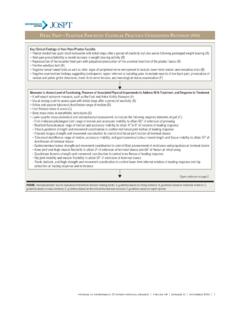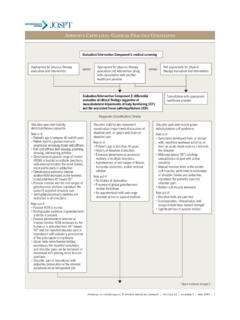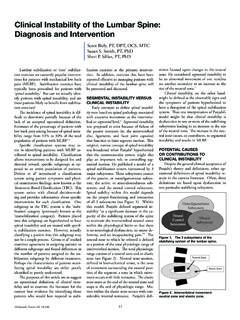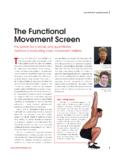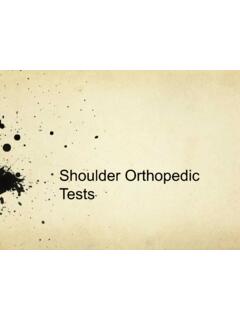Transcription of Neck Pain: Revision 2017
1 Clinical Practice Guidelines PETER R. BLANPIED, PT, PhD ANITA R. GROSS, PT, MSc JAMES M. ELLIOTT, PT, PhD LAURIE LEE DEVANEY, PT, MSc DEREK CLEWLEY, DPT DAVID M. WALTON, PT, PhD CHERYL SPARKS, PT, PhD ERIC K. ROBERTSON, PT, DPT. Neck Pain: Revision 2017. Clinical Practice Guidelines Linked to the Downloaded from at on July 7, 2017. For personal use only. No other uses without permission. International Classification of Functioning, Disability and Health From the Orthopaedic Section of the American Physical Therapy Association Copyright 2017 Journal of Orthopaedic & Sports Physical Therapy . All rights reserved. J Orthop Sports Phys Ther. 2017;47(7):A1-A83. SUMMARY OF RECOMMENDATIONS.. A2. INTRODUCTION.. A4.
2 Journal of Orthopaedic & Sports Physical Therapy .. A5. CLINICAL GUIDELINES: Impairment/Function-Based Diagnosis.. A11. CLINICAL GUIDELINES: Examination.. A18. CLINICAL GUIDELINES: Interventions.. A25. AUTHOR/REVIEWER AFFILIATIONS AND CONTACTS.. A44. REFERENCES.. A45. REVIEWERS: Roy D. Altman, MD Paul Beattie, PT, PhD Eugene Boeglin, DPT. Joshua A. Cleland, PT, PhD John D. Childs, PT, PhD John DeWitt, DPT Timothy W. Flynn, PT, PhD. Amanda Ferland, DPT Sandra Kaplan, PT, PhD David Killoran, PhD Leslie Torburn, DPT. For author, coordinator, contributor, and reviewer affiliations, see end of text. 2017 Orthopaedic Section, American Physical Therapy Association (APTA), Inc, and the Journal of Orthopaedic & Sports Physical Therapy.
3 The Orthopaedic Section, APTA, Inc, and the Journal of Orthopaedic & Sports Physical Therapy consent to the reproduction and distribution of this guideline for educational purposes. Address correspondence to Brenda Johnson, ICF-Based Clinical Practice Guidelines Coordinator, Orthopaedic Section, APTA, Inc, 2920 East Avenue South, Suite 200, La Crosse, WI 54601. E-mail: Neck Pain: Clinical Practice Guidelines Revision 2017. Summary of Recommendations*. PATHOANATOMICAL FEATURES/DIFFERENTIAL DIAGNOSIS Neck pain with headaches (cervicogenic headache). Clinicians should perform assessments and identify clinical Neck pain with radiating pain (radicular). A. findings in patients with neck pain to determine the potential for the presence of serious pathology (eg, infection, cancer, cardiac INTERVENTIONS: NECK PAIN WITH MOBILITY DEFICITS.)
4 Involvement, arterial insufficiency, upper cervical ligamentous insuffi- Acute ciency, unexplained cranial nerve dysfunction or fracture), and refer For patients with acute neck pain with mobility deficits: for consultation as indicated. B Clinicians should provide thoracic manipulation, a program of neck ROM exercises, and scapulothoracic and upper IMAGING. extremity strengthening to enhance program adherence. A Clinicians should utilize existing guidelines and appropriate- ness criteria in clinical decision making regarding referral or Clinicians may provide cervical manipulation and/or consultation for imaging studies for traumatic and nontraumatic C. mobilization. Downloaded from at on July 7, 2017. For personal use only.
5 No other uses without permission. neck pain in the acute and chronic stages. Subacute EXAMINATION OUTCOME MEASURES For patients with subacute neck pain with mobility deficits: Clinicians should use validated self-report questionnaires for B Clinicians should provide neck and shoulder girdle endurance A. exercises. Copyright 2017 Journal of Orthopaedic & Sports Physical Therapy . All rights reserved. patients with neck pain, to identify a patient's baseline status and to monitor changes relative to pain, function, disability, and psycho- social functioning. C Clinicians may provide thoracic manipulation and cervical manipulation and/or mobilization. EXAMINATION ACTIVITY LIMITATIONS AND Chronic PARTICIPATION MEASURES For patients with chronic neck pain with mobility deficits: F Clinicians should utilize easily reproducible activity limitation Clinicians should provide a multimodal approach of the and participation restriction measures associated with the B.
6 Following: patient's neck pain to assess the changes in the patient's level of function over the episode of care. Thoracic manipulation and cervical manipulation or Journal of Orthopaedic & Sports Physical Therapy . mobilization Mixed exercise for cervical/scapulothoracic regions: neuromus- EXAMINATION PHYSICAL IMPAIRMENT MEASURES cular exercise (eg, coordination, proprioception, and postural When evaluating a patient with neck pain over an episode of training), stretching, strengthening, endurance training, aerobic B conditioning, and cognitive affective elements care, clinicians should include assessments of impairments of body function that can establish baselines, monitor changes over Dry needling, laser, or intermittent mechanical/manual traction time, and be helpful in clinical decision making to rule in or rule out (1) neck pain with mobility deficits, including cervical active range of C Clinicians may provide neck, shoulder girdle, and trunk en- motion (ROM)
7 , the cervical flexion-rotation test, and cervical and durance exercise approaches and patient education and thoracic segmental mobility tests ; (2) neck pain with headache, in- counseling strategies that promote an active lifestyle and address cluding cervical active ROM, the cervical flexion-rotation test, and cognitive and affective factors. upper cervical segmental mobility testing; (3) neck pain with radiat- ing pain, including neurodynamic testing, Spurling's test, the distrac- INTERVENTIONS: NECK PAIN WITH MOVEMENT. tion test, and the Valsalva test; and (4) neck pain with movement COORDINATION IMPAIRMENTS. coordination impairments, including cranial cervical flexion and neck Acute flexor muscle endurance tests .
8 Clinicians should include algometric For patients with acute neck pain with movement coordination assessment of pressure pain threshold for classifying pain. impairments (including WAD): DIAGNOSIS/CLASSIFICATION B Clinicians should provide the following: Clinicians should use motion limitations in the cervical and Education of the patient to C. upper thoracic regions, presence of cervicogenic headache, - Return to normal, nonprovocative preaccident activities as history of trauma, and referred or radiating pain into an upper ex- soon as possible tremity as useful clinical findings for classifying a patient with neck - Minimize use of a cervical collar pain into the following categories: - Perform postural and mobility exercises to decrease pain and Neck pain with mobility deficits increase ROM.
9 Neck pain with movement coordination impairments (including Reassurance to the patient that recovery is expected to occur whiplash-associated disorder [WAD]) within the first 2 to 3 months. a2 | july 2017 | volume 47 | number 7 | journal of orthopaedic & sports physical therapy Neck Pain: Clinical Practice Guidelines Revision 2017. Summary of Recommendations* (continued). B Clinicians should provide a multimodal intervention ap- C Clinicians may provide C1-2 self-sustained natural apophyseal proach including manual mobilization techniques plus exer- glide (self-SNAG) exercise. cise (eg, strengthening, endurance, flexibility, postural, coordination, aerobic, and functional exercises) for those patients expected to ex- Subacute perience a moderate to slow recovery with persistent impairments.
10 For patients with subacute neck pain with headache: B Clinicians should provide cervical manipulation and C Clinicians may provide the following for patients whose mobilization. condition is perceived to be at low risk of progressing toward chronicity: C Clinicians may provide C1-2 self-SNAG exercise. A single session consisting of early advice, exercise instruction, and education Chronic A comprehensive exercise program (including strength and/or For patients with chronic neck pain with headache: endurance with/without coordination exercises). Downloaded from at on July 7, 2017. For personal use only. No other uses without permission. Transcutaneous electrical nerve stimulation (TENS) B Clinicians should provide cervical or cervicothoracic manipu- lation or mobilizations combined with shoulder girdle and F Clinicians should monitor recovery status in an attempt to neck stretching, strengthening, and endurance exercise.



